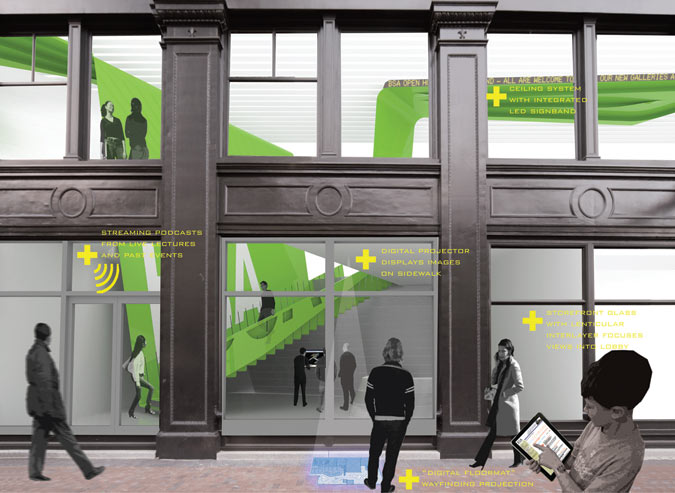
Founded as a professional organization in 1867, the Boston Society of Architects (BSA) is one the oldest and the largest AIA chapters in the country. Long located in a historic, if cramped space at 52 Broad Street, the building lacks street frontage, preventing the chapter’s leadership from reaching a broader public. So with the same reinvigoration aims as New York’s Center for Architecture, the BSA is building a new headquarters, one it is hoped will engage chapter members as well as the public at large.
The chapter found space in a new building—built behind a preserved facade—at 290 Congress Street, near the Greenway, developed by Boston Properties. The chapter benefitted from Chapter 91, a Massachusetts law that reserves public uses for waterfront properties; the site is alongside Congress just as it springs over the river. The BSA is paying roughly the same rent for three times the space of their old offices.
|
Rendering of the gallery layout (left) and an axonometric showing circulation from ground to gallery spaces (right).
[Click to enlarge.] |
||
After a two-stage competition open to BSA members only, which garnered 19 submissions, the jury selected Howeler + Yoon (H+Y) as the winner. Other finalists included Single Speed Design, Merge Architects, and Hashim Sarkis Studio. The chapter wanted to “level the playing field” between large firms and small, according to BSA president Audrey O’Hagan, so they limited the competition to two weeks and only a single presentation board.
Hoewler + Yoon’s design calls for a dramatic, brightly colored staircase visible at the ground level entrance. The staircase wraps up onto the wall and then curves onto the ceiling, drawing the eye and, the BSA hopes, visitors up to the second floor’s 5,000-square-foot gallery. Four conference rooms with curved walls divide the space but also allow for chance run-ins within the gallery. “The conference rooms contaminate the gallery space,” Howeler said. “In the old BSA, the most active space was the elevator. We want to retain the possibility of chance encounters.” Offices are located behind the gallery. A large auditorium is located elsewhere in the building and was not under the purview of the competition.
Though the competition board shows the sculptural staircase in vivid green, H+Y is toying with other color and graphics schemes. “We want it to be punchy,” Howeler said.
“We tried not to be too prescriptive, to allow for some creativity in programming strategies,” O’Hagan said. H+Y is also investigating ways in which technology can be integrated into the architecture. “The BSA is a content producer, from lectures and webinars, to workshops on mold abatement,” Howeler said. “So we’re looking at ways in which technology within the space can make it more valuable to members and public.” He cited smart phone applications that would be available only within the space as one idea.
Howeler points out that the second floor gallery is twice the size of MoMA’s gallery for the architecture and design permanent collection. While there are university galleries and at least one alternative gallery—pinkcomma—there are no institutional galleries in Boston wholly devoted to architecture and design. Howeler also said the chapter intends to expand its exhibition program and hire its first full time curator.
For H+Y, the BSA’s stated goals for the competition were met. “Competitions like this are really important for younger firms to get opportunities so you’re not being judged solely on the number of architecture centers you’ve designed,” Howeler said.